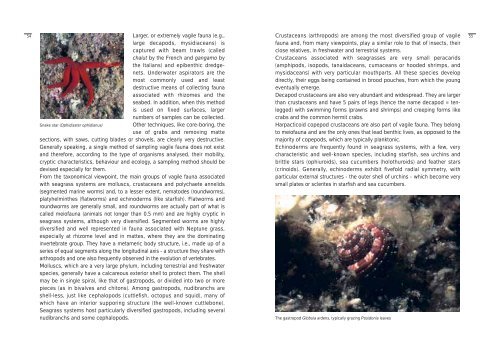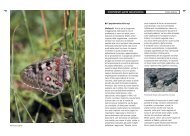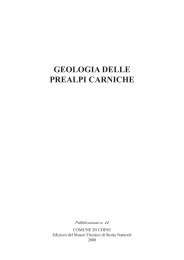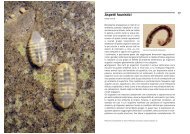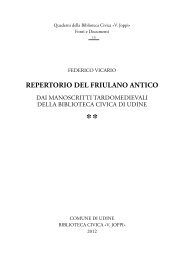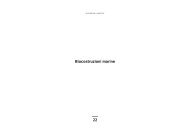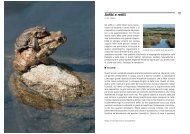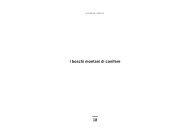Fauna: invertebrates - Udine Cultura
Fauna: invertebrates - Udine Cultura
Fauna: invertebrates - Udine Cultura
You also want an ePaper? Increase the reach of your titles
YUMPU automatically turns print PDFs into web optimized ePapers that Google loves.
Larger, or extremely vagile fauna (e.g.,<br />
large decapods, mysidiaceans) is<br />
captured with beam trawls (called<br />
chalut by the French and gangamo by<br />
the Italians) and epibenthic dredgenets.<br />
Underwater aspirators are the<br />
most commonly used and least<br />
destructive means of collecting fauna<br />
associated with rhizomes and the<br />
seabed. In addition, when this method<br />
is used on fixed surfaces, larger<br />
numbers of samples can be collected.<br />
Snake star (Ophidiaster ophidianus)<br />
Other techniques, like core-boring, the<br />
use of grabs and removing matte<br />
sections, with saws, cutting blades or shovels, are clearly very destructive.<br />
Generally speaking, a single method of sampling vagile fauna does not exist<br />
and therefore, according to the type of organisms analysed, their mobility,<br />
cryptic characteristics, behaviour and ecology, a sampling method should be<br />
devised especially for them.<br />
From the taxonomical viewpoint, the main groups of vagile fauna associated<br />
with seagrass systems are molluscs, crustaceans and polychaete annelids<br />
(segmented marine worms) and, to a lesser extent, nematodes (roundworms),<br />
platyhelminthes (flatworms) and echinoderms (like starfish). Flatworms and<br />
roundworms are generally small, and roundworms are actually part of what is<br />
called meiofauna (animals not longer than 0.5 mm) and are highly cryptic in<br />
seagrass systems, although very diversified. Segmented worms are highly<br />
diversified and well represented in fauna associated with Neptune grass,<br />
especially at rhizome level and in mattes, where they are the dominating<br />
invertebrate group. They have a metameric body structure, i.e., made up of a<br />
series of equal segments along the longitudinal axis - a structure they share with<br />
arthropods and one also frequently observed in the evolution of vertebrates.<br />
Molluscs, which are a very large phylum, including terrestrial and freshwater<br />
species, generally have a calcareous exterior shell to protect them. The shell<br />
may be in single spiral, like that of gastropods, or divided into two or more<br />
pieces (as in bivalves and chitons). Among gastropods, nudibranchs are<br />
shell-less, just like cephalopods (cuttlefish, octopus and squid), many of<br />
which have an interior supporing structure (the well-known cuttlebone).<br />
Seagrass systems host particularly diversified gastropods, including several<br />
nudibranchs and some cephalopods.<br />
Crustaceans (arthropods) are among the most diversified group of vagile<br />
fauna and, from many viewpoints, play a similar role to that of insects, their<br />
close relatives, in freshwater and terrestrial systems.<br />
Crustaceans associated with seagrasses are very small peracarids<br />
(amphipods, isopods, tanaidaceans, cumaceans or hooded shrimps, and<br />
mysidaceans) with very particular mouthparts. All these species develop<br />
directly, their eggs being contained in brood pouches, from which the young<br />
eventually emerge.<br />
Decapod crustaceans are also very abundant and widespread. They are larger<br />
than crustaceans and have 5 pairs of legs (hence the name decapod = tenlegged)<br />
with swimming forms (prawns and shrimps) and creeping forms like<br />
crabs and the common hermit crabs.<br />
Harpacticoid copepod crustaceans are also part of vagile fauna. They belong<br />
to meiofauna and are the only ones that lead benthic lives, as opposed to the<br />
majority of copepods, which are typically planktonic.<br />
Echinoderms are frequently found in seagrass systems, with a few, very<br />
characteristic and well-known species, including starfish, sea urchins and<br />
brittle stars (ophiuroids), sea cucumbers (holothuroids) and feather stars<br />
(crinoids). Generally, echinoderms exhibit fivefold radial symmetry, with<br />
particular external structures - the outer shell of urchins - which become very<br />
small plates or sclerites in starfish and sea cucumbers.<br />
54 55<br />
The gastropod Gibbula ardens, typically grazing Posidonia leaves


